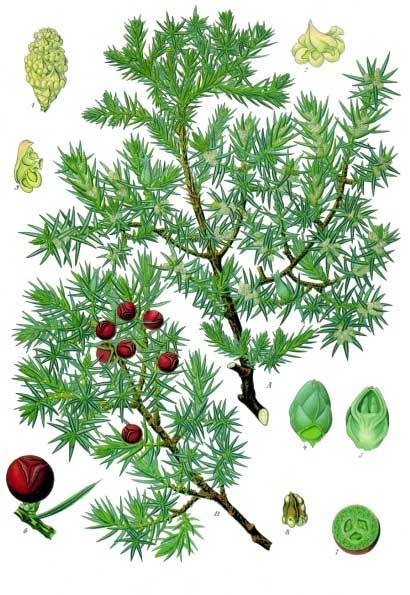
Juniperus oxycedrus
Superregnum: Eukaryota
Regnum: Plantae
Divisio: Tracheophyta
Divisio: Pinophyta
Classis: Pinopsida
Ordo: Pinales
Familia: Cupressaceae
Subfamilia: Cupressoideae
Genus: Juniperus
Sectio: Juniperus sect. Juniperus
Species: Juniperus oxycedrus
Name
Juniperus oxycedrus L. Sp. Pl. 2: 1038 (1753)
References
Primary references
Linnaeus, C. 1753. Species plantarum, exhibentes plantas rite cognitas, ad genera relatas, cum differentiis specificis, nominibus trivialibus, synonymis selectis, locis natalibus, secundum systema sexuale digestas. Tomus II. Pp. 561–1200, [1–30, index], [1, err.]. Impensis Laurentii Salvii, Holmiae [Stockholm]. BHL Reference page. [see page 1038]
Additional references
Adams, R.P. 2004. Junipers of the World: The genus Juniperus. Trafford. ISBN 1-4120-4250-X.
Vernacular names
العربية: شجرة الكاد
català: Càdec
English: Western Prickly Juniper
Esperanto: Pika junipero
español: Enebro de miera
suomi: Okakataja
français: Genévrier cade
italiano: Ginepro rosso
日本語: ケードネズ
português: Oxicedro ocidental
sardu: tzinnibiri mascu
Türkçe: Katran ardıcı
Juniperus oxycedrus, vernacularly called Cade, cade juniper, prickly juniper, prickly cedar, or sharp cedar, is a species of juniper, native across the Mediterranean region from Algeria and Portugal, north to southern France, east to westernmost Iran, and south to Lebanon and Israel, growing on a variety of rocky sites from sea level up to 1,600 metres (5,200 feet) in elevation.[3][1] The specific epithet oxycedrus means "sharp cedar" and this species may have been the original cedar or cedrus of the ancient Greeks.[4][5]
Description
Juniperus oxycedrus is very variable in shape, forming a spreading shrub 2–3 metres (6+1⁄2–10 feet) tall to a small erect tree 10–15 m (33–49 ft) tall. It has needle-like leaves in whorls of three; the leaves are green, 5–20 millimetres (1⁄4–3⁄4 inch) long and 1–2 mm (1⁄32–3⁄32 in) broad, with a double white stomatal band (split by a green midrib) on the inner surface. It is usually dioecious, with separate male and female plants. The seed cones are berry-like, green ripening in 18 months to orange-red with a variable pink waxy coating; they are spherical, 7–12 mm (1⁄4–1⁄2 in) diameter, and have three or six fused scales in 1–2 whorls, three of the scales with a single seed. The seeds are dispersed when birds eat the cones, digesting the fleshy scales and passing the hard seeds in their droppings. The pollen cones are yellow, 2–3 mm (1⁄16–1⁄8 in) long, and fall soon after shedding their pollen in late winter or early spring.[3][6][7]
As to be expected from the wide range, J. oxycedrus is very variable. One recent study[6][8][9] splits it into three species, though other authorities[3] do not accept this:
Juniperus oxycedrus L. – Western prickly juniper. Southwest Europe, in eastern Portugal and Spain east to southern France, northwest Italy, Corsica, and Sardinia, and northwest Africa from Morocco east to Tunisia. Leaves long (10–20 mm or 3⁄8–13⁄16 in), narrow-based; cones smooth.
Juniperus navicularis Gand. (syn. J. oxycedrus subsp. transtagana) – Portuguese prickly juniper. Coastal southwest Portugal. Leaves short (5–12 mm or 3⁄16–1⁄2 in); cones smooth.
Juniperus deltoides R.P.Adams – Eastern prickly juniper. Central Italy east to Iran and Israel. Leaves long (10–20 mm or 3⁄8–13⁄16 in), broad-based; cones with raised scale edges.
Subspecies
An additional variety or subspecies J. oxycedrus var. badia H.Gay (syn. J. oxycedrus subsp. badia (H.Gay) Debeaux) is distinguished on the basis of larger cones (10–13 mm or 3⁄8–1⁄2 in diameter), tinged purple when mature; it is described from northern Algeria, and also reported from Portugal and Spain.[3][6]
A further species Juniperus macrocarpa,[6] confined to Mediterranean coastal sands, is more distinct but has also often been treated as a subspecies of prickly juniper, as J. oxycedrus subsp. macrocarpa;[3] it differs in the broader leaves (2–3 mm or 1⁄16–1⁄8 in wide), and larger cones (12–18 mm or 1⁄2–11⁄16 in wide).
Other close relatives of J. oxycedrus include Juniperus brevifolia on the Azores, Juniperus cedrus on the Canary Islands and Juniperus formosana in eastern Asia.[3][6]
Uses
Cade oil is the essential oil obtained through destructive distillation of the wood of this shrub. It is a dark, aromatic oil with a strong smoky smell which is used in some cosmetics and (traditional) skin treatment drugs, as well as incense.[10][11] Cade oil has, on rare occasions, caused severe allergic reactions in infants.[12]
Leaves and mature cones, Spain
Leaves and immature cones, southern France
Central Spain
Bark, Central Spain
References
Farjon, A. (2013). "Juniperus oxycedrus". IUCN Red List of Threatened Species. 2013: e.T42243A2965838. doi:10.2305/IUCN.UK.2013-1.RLTS.T42243A2965838.en. Retrieved 12 November 2021.
The Plant List: A Working List of All Plant Species, retrieved 11 February 2017
Farjon, A. (2005). Monograph of Cupressaceae and Sciadopitys. Royal Botanic Gardens, Kew. ISBN 1-84246-068-4
Meiggs, R. 1982. Trees and Timber in the Ancient Mediterranean World.
MARIA PEPLER-HARCOMBE, ALETTA (2011). Ancient Furniture in Context: From Ancient Production, Preservation To Modern-Day Reconstruction And Conservation. South Africa: UNIVERSITY OF SOUTH AFRICA.
Adams, R. P. (2004). Junipers of the World. Trafford. ISBN 1-4120-4250-X
Arboretum de Villardebelle: photos of cones and shoots
Adams, R. P. (2000). Systematics of Juniperus section Juniperus based on leaf essential oils and RAPD DNA fingerprinting. Biochem. Syst. Ecol. 28: 515-528 available online (pdf file) Archived 2006-03-18 at the Wayback Machine
Adams, R. P. (2004). Juniperus deltoides, a new species and nomenclatural notes on Juniperus polycarpos and J. turcomanica (Cupressaceae). Phytologia 86: 49 - 53 available online (pdf file) Archived 2006-03-18 at the Wayback Machine
1911 British Pharmacopaea: Cade Oil
1918 US Dispensatory: Cade Oil
Achour S, Abourazzak S, Mokhtari A, Soulaymani A, Soulaymani R, Hida M (2011). "Juniper tar (cade oil) poisoning in new born after a cutaneous application". BMJ Case Rep. 2011: bcr0720114427. doi:10.1136/bcr.07.2011.4427. PMC 3207742. PMID 22675090.
Retrieved from "http://en.wikipedia.org/"
All text is available under the terms of the GNU Free Documentation License

